- Incredibly, the Opportunity and Spirit
rovers on Mars are now entering their third year of operation. Originally,
the planned mission was to last 6 months. In October 2005 the book
"What NASA Isn't Telling You About Mars" was released. That book
documented using incontrovertible evidence the games that NASA plays with
the public - including the on-going fiasco about the true color
of Mars' atmosphere. Apparently the book's information caused a number
of people at NASA to take notice. Several covert visits by NASA to the
www.data4science.net website where the book is sold have been detected.
These visits originated at several NASA installations. There
were also two visits from one NASA office with an ominous title -
"Office of the Chief Information Officer."
-
- But the games are not over yet and are
not likely to end soon. The evidence and facts about unusual happenings
and objects on Mars are right out in plain sight, if one knows what
to look for.
-
- SOLAR PANELS NOW COATED WITH DUST AND DIRT-
YET STILL FUNCTION?
-
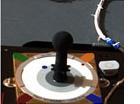
-
- Spirit rover showing sundial color
reference disk before launch (NASA-Cornell)
-
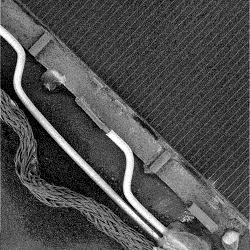
-
- Day 505 - Close-up of solar panel dust
coating using micro-imager. Note the soldered end of the white wire covered
in dust and dirt where it is attached to the panel's electricity collector
strip. This was a strip of shiny metal. Was it the maid's day
off? (NASA)
-
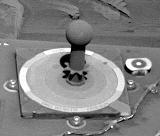 |
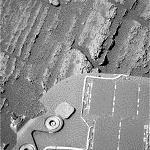 |
Day 758 - Spirit Rover sundial
(NASA-JPL) |
Day 750 - solar panel (lower right corner)
(NASA-JPL) |
-
- The designers of the rovers never expected
them to function for more than 6 months according to NASA. As solar
powered vehicles, mission lifetime would be mainly limited by
dust accumulation on the solar panels. Suddenly one day into the first
year of the mission, battery voltage levels routinely sent back to
earth by the rover suddenly increased. Later, images of whirlwinds were
recorded by the rover. For many months a sporadic whirlwind
had cleaned up the solar panels at Gusev crater. A series of still images
from the rover were put into a movie format, which clearly showed whirlwinds
moving rapidly across the surface.
-
- In the past, NASA had previously stated
the planet had "almost no atmosphere." The agency finally announced
that these whirlwinds were "electrical vortices" shortly
after thunderbolts.info announced this theory. However, no explanation
for the spontaneous creation of these whirlwinds has even been
provided by the agency. [1]
-
- Recent images from Mars such as those
above have shown the cleaning action has stopped for the Spirit rover.
The rings around the sundial's post are white and grey scale reference
rings intended for calibrating video cameras while on the planet. These
rings are now almost completely obscured by a layer of dust and
dirt. Reviewing dozens of rover images have shown that
a layer of dust and dirt has been present for several months now.
-
- Solar panels are now covered
with a nearly opaque layer of dust and dirt (compare the top and bottom images.)
Yet the rover continues to charge its batteries and still function.
Even though it is 45 million miles further from the sun than we are? A
mystery indeed! A review of NASA's image list has shown
that almost every day for the past several months, images have continued
to be transmitted back to earth. (A similar fate will visit the Opportunity
rover's solar cells which is located on the other side of the planet.
However, the other rover is not our focus here.)
-
- My last update article on Mars was titled "Part
2 - What NASA Isn't Telling You About Mars." [1] NASA data
provided evidence of temperature measurement contradictions. Temperature
measurements didn't agree with ice formation, and seemed to indicate
that some type of atmosphere must be present to explain the observations
and images. New discoveries by researchers show that hydrogen molecules
are present in the planet's atmosphere. Hydrogen molecules were
suspected to be present for many years, even though it is a very light
gas which always rises. Could there be any significant quantity present
in free-form close to the planet's surface?
-
-
- Scientists now believe that
95% of Mars' atmosphere is carbon dioxide and very thin. This CO2 level is
about nine times higher than Earth's atmosphere, which is also far
more dense. Experiments performed on earth have demonstrated that the
Sun can split carbon dioxide into its component parts, carbon monoxide
and oxygen. [2] This raises the question about whether a form of life we
may know nothing about or can even understand yet, might exist on
the planet.
-
-
- IMAGING CURIOSITIES
-
- As you examine the following images,
keep in mind that straight lines are not common-place in nature.
-
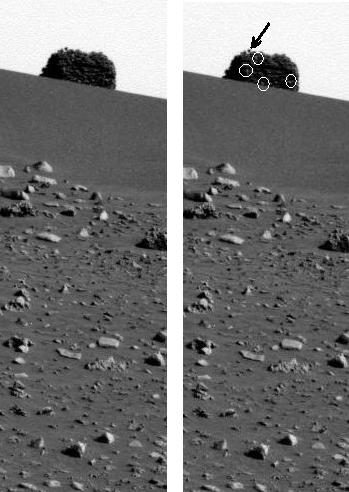
-
-
- Could this be a tree or plant in the
distance? Note the tiny dark round object (black arrow) that appears
to be suspended just above the upper left corner of it. A clump of leaves
on a branch might appear this way from such a great distance. It also appears
that sunlight is visible through it in various areas (white circles.) Rock
shadows on the ground indicate the sun is off to the right in the image,
near the 2:00 position. However, the angle suggests it could still shine
through openings in the object. The surface of the object facing the
camera appears to be in the shade.
-
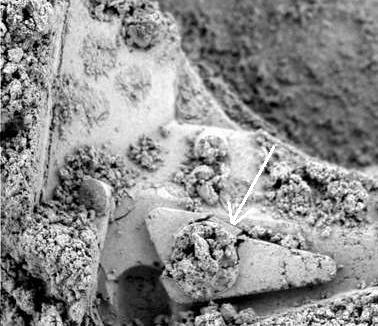
-
-
- Micro-imager from day 380 shows an outline
of a mechanical part. At first glance this appears to be nothing more
than an imprint in the fine soil from a rover tool. However a
perfectly formed machine nut is visible (see white arrow.) Could this be
a mechanical part which has nearly crumbled to dust? What can explain the
presence of the nut which is appears to be separated from the material
surrounding it? (NASA-JPL)
-
-
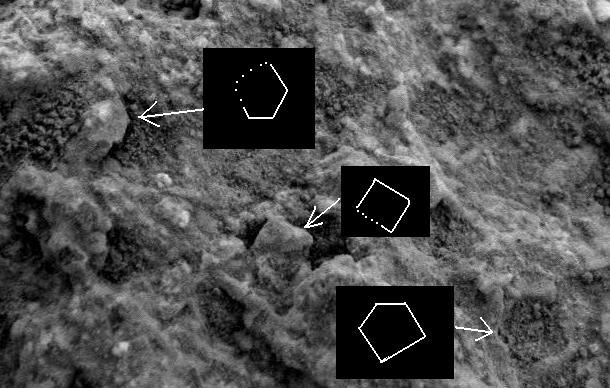
-
- Micro-imager from day 529 showing several
polygon shapes. More polygon shapes were found in numerous images
from the rover. The source of these shapes is unknown. (NASA-JPL)
-
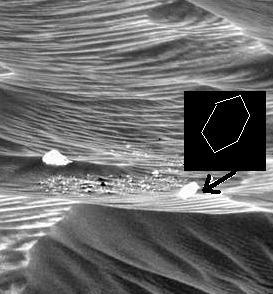
-
- Day 708 - Another hexagon shape in the
distance from panoramic camera, on top of what appears to be a sand dune. (NASA-JPL)
-
-
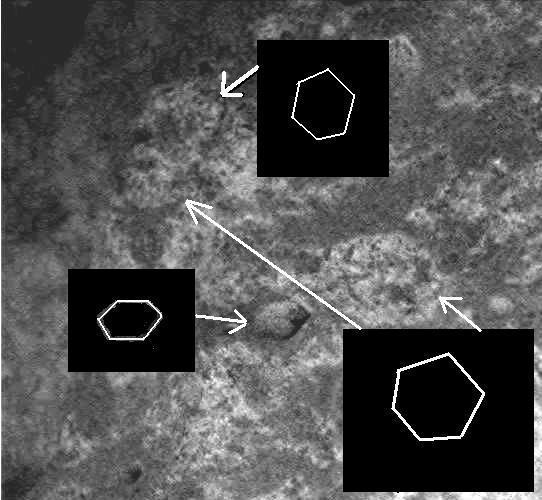
-
-
- Day 553 - more hexagonal shapes all in
the same micro-image (NASA-JPL)
-
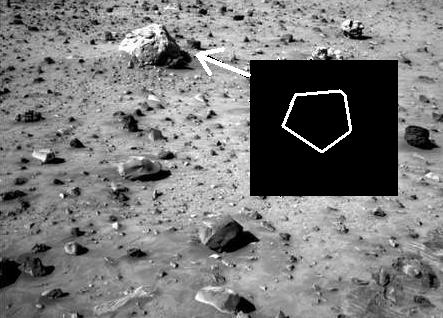
-
-
- Day 727 - Another pentagon shaped
object imaged by the navigation camera. Shadows appear to show the entire
object may have this same shape. Rover tracks can be seen in the lower
right corner (small parallel lines) which helps to provide scale and distance.
-
-
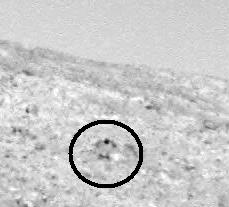
-
-
- Day 758 - Circular Black dot in the far
distance high on the crater's rim, far from the camera. Distance is more
than one mile. Could this be part of a cave or a recess in the face
of the hill?
-
- In the book are many other images of
polygon objects. Below are just two of more than 160:
-

-
-
- Fig. 52 from the E-book. A massive
pentagon shaped object that stands approximately 4ft. high. The object
appears to be embedded in a rock. ("What NASA Isn't Telling You
Mars")
-
-

-
-
- Fig. 108 from the E-book. Among the most
incredible devices found to date is this object of unknown design. In the
upper left corner on the side of the object, note the faintly visible polygon-shape
with a faint dot in the center. This object is actually about 150-200ft.
from the camera and is about 3ft. long. Picture clarity problems are the
result of magnification and lack of resolution from the original NASA image.
("What NASA Isn't Telling You Mars")
-
-
- There are a number of unexplained
objects lying on the planet's surface. It was the main reason why the this
author promptly went public with an E-book about numerous discoveries
made last summer.
-
- Most of the oddities were found near
the rim of Gusev crater. Objects began to appear in images about two
months after the vehicle landed. Each rover averages about 242ft. of travel per
day, and it takes almost 22 days to move one mile.
-
- More research will be done to identify
other images of interest out of more than 50,000 images. NASA is virtually
obsessed with "finding signs of water" according to their public
statements. However, far more important signs of past life and
possible current life abound on the planet which they appear to be
ignoring. If these discoveries and others are ever publicized by scientists
and accepted by the astronomy community, it will turn current planetary
theories inside-out about the existence of life elsewhere.
-
- And this is exactly what needs to happen.
-
- HOW YOU CAN HELP MOVE RESEARCH FORWARD
-
- Proceeds from sales of the E-book "What
NASA Isn't Telling You About Mars" help further research on Mars,
and make articles and books possible. It also helps independent research
move forward and finance operating costs for the non-profit website
. Please visit www.data4science.net/book for more details and to read sample pages from
the E-book. It is also available on CD-ROM.
-
- Ted Twietmeyer
-
- REFERENCES
-
- [1 http://www.rense.com/general69/tt.htm
-
- [2] http://www.space.com/scienceastronomy/solars
ystem/mars_water_011129.html
|